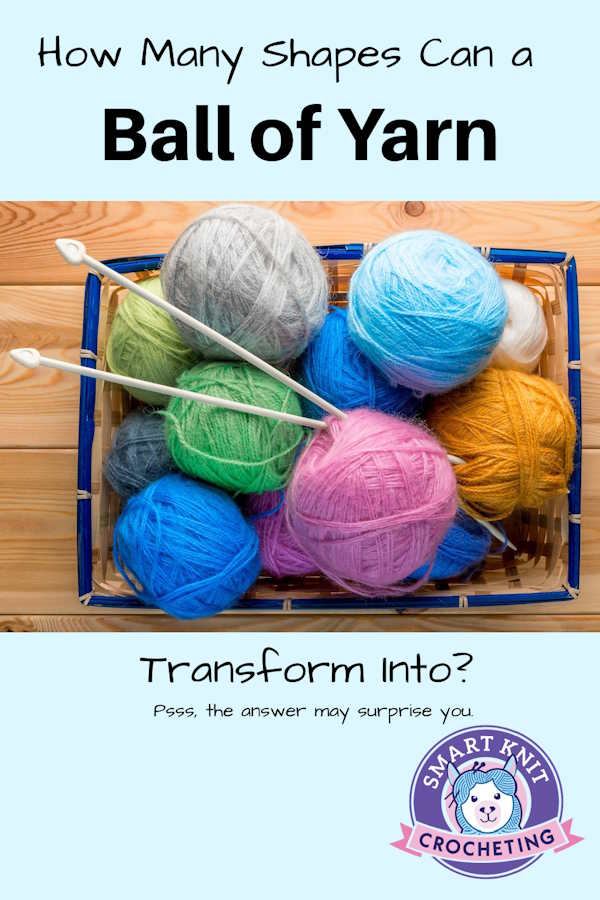- Home
- Ball of Yarn
Buying a Ball of Yarn: Unraveling Your Options
So, you're in the market for a ball of yarn? Whether you're a seasoned knit, crocheter, or curious beginner, the sheer variety of options can be overwhelming.
Let's break down the different ways you can purchase yarn, exploring the pros and cons of each and the types of fibers you'll likely encounter.
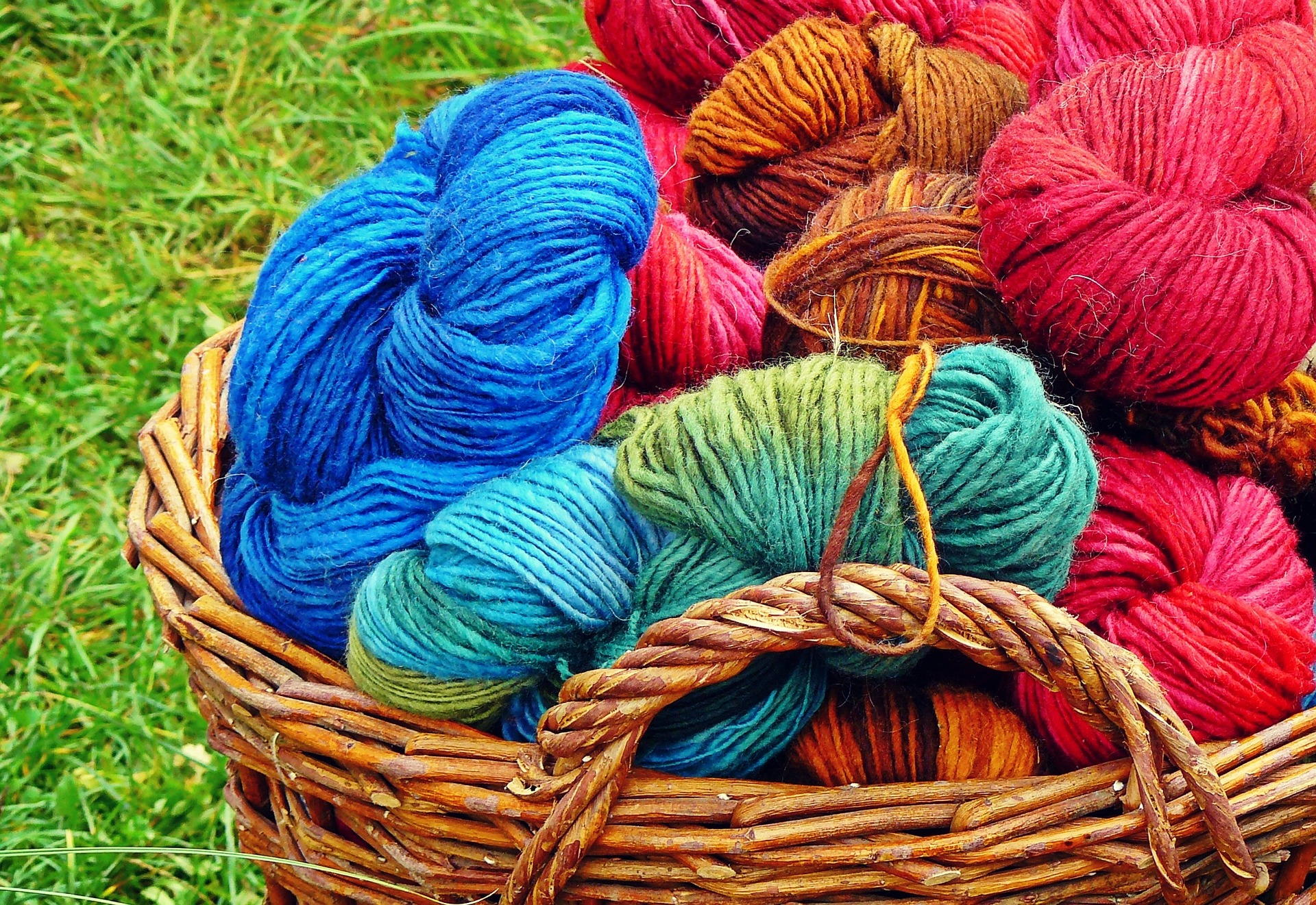
1. The Classic Ball (or Center-Pull Ball)
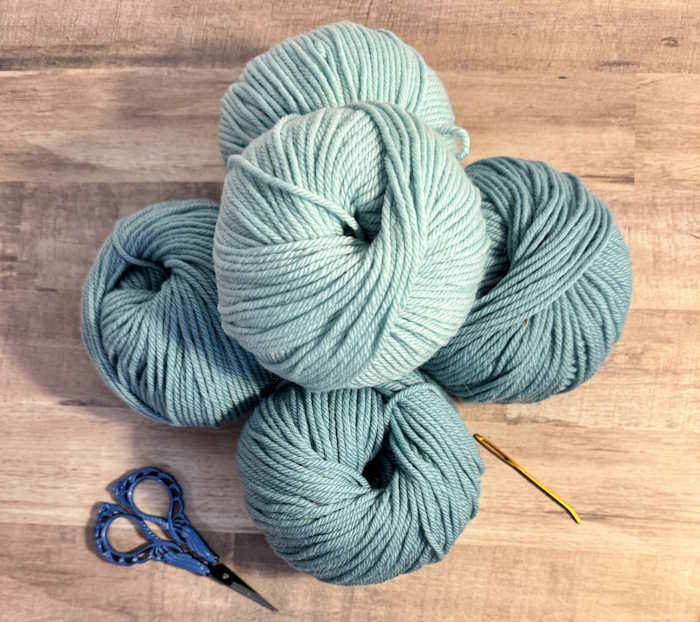
Description: A spherical shape with yarn wound around itself, allowing you to pull from the center.
Advantages: It is convenient, portable, and less prone to tangling. It is easy to use whether you knit or crochet.
Disadvantages: It can roll away, but it is sometimes difficult to wind back into a ball if unwound.
Fiber Content: Wide range, from acrylic to natural fibers like cotton, wool, and blends.
Typical Yarn Weights: Most common for medium weights (worsted, Aran) and lighter weights (fingering, sport).
2. The Hank
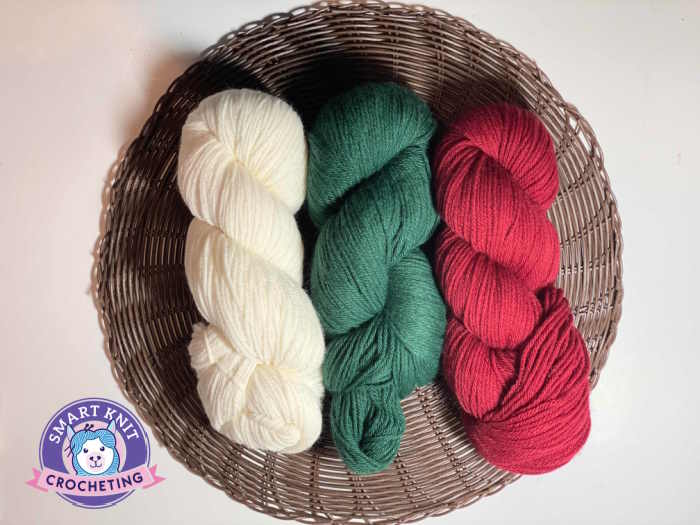
Description: A large, loose loop of yarn tied together in several places to prevent tangling. Requires winding into a ball before use. It is sold as a twisted hank that needs to be untwisted, laid flat, removed yarn tags, and then wound into a ball by hand or using a yarn winder.
Advantages: It is often used for high-end yarns, allows fiber to breathe, and lays flat, so it takes up less storage space.
Disadvantages: Winding is needed before use, and it can be easily tangled if not handled carefully.
Fiber Content: Typically found with luxury fibers like silk, cashmere, merino wool, or delicate hand-dyed yarns.
Typical Yarn Weights: Often used for fingering, lace, and other fine-weight yarns where the fiber benefits from being loosely wound.
3. The Skein
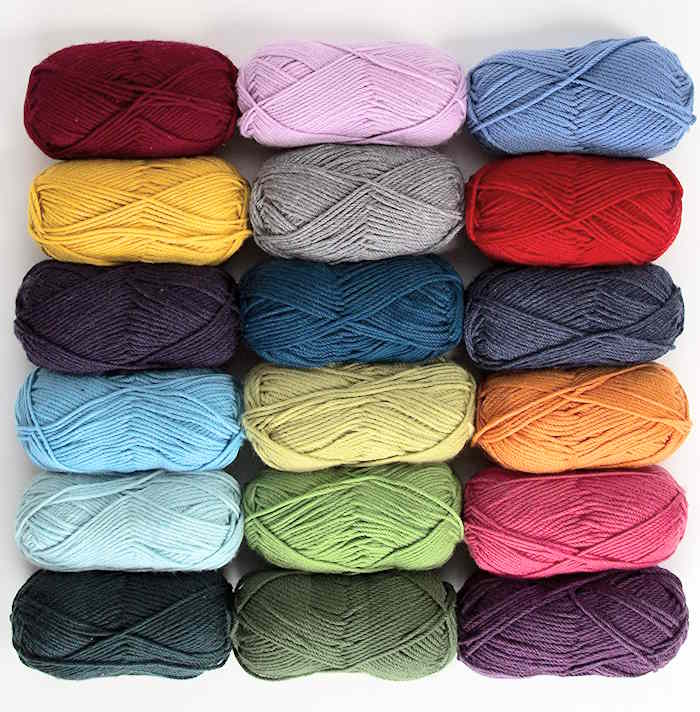
Description: Yarn wound into a long, cylindrical shape with flat ends. It may require winding into a ball before use. It either comes wound so the beginning of the yarn is on the outside of the skein or as a center-pull skein where the end is in the center and can be pulled and worked directly from the inside. Not all skeins are the same size. Some are long, but others are shorter, fatter versions and often have less yardage on them.
Advantages: Easy to store, compact, suitable for displaying color changes in variegated yarns.
Disadvantages: It needs winding and can collapse easily if not stored properly. If not wound, the last part of the skin may tangle.
Fiber Content: Wide range, commonly found with acrylic, cotton, wool, and blends.
Typical Yarn Weights: Common for various weights, from fingering to bulky.
4. The Cake
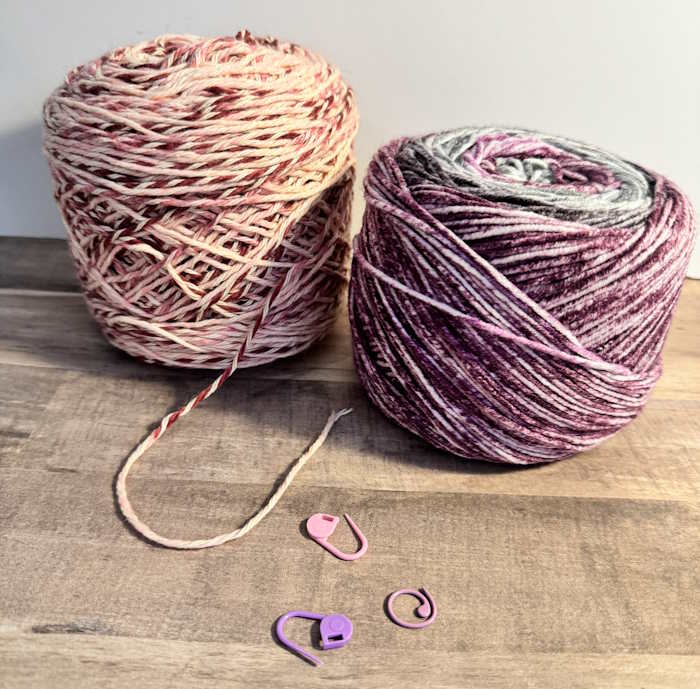
Description: Similar in shape to a cake, with yarn wound around a cylindrical core.
Advantages: Stable, less likely to roll, easy to wind from the outside or center.
Disadvantages: It can be bulky, and it is sometimes difficult to find the end of the yarn.
Fiber Content: Primarily machine-wound, suitable for acrylic, cotton, wool, and blends.
Typical Yarn Weights: Suitable for a wide range of weights, especially popular for medium weights.
5. Cones and Tubes
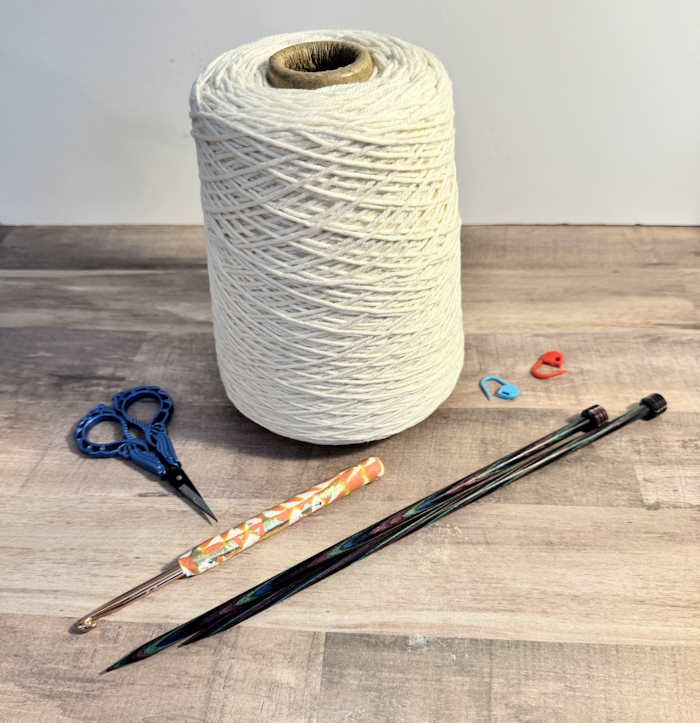 Cones and Tubes
Cones and TubesDescription: Large, cone-shaped, or cylindrical packages designed for heavy use or weaving.
Advantages: Economical for large projects, often used for specific purposes like weaving.
Disadvantages: Bulky, requires a yarn holder or swift for use. Not easy to use when traveling.
Fiber Content: Often found with cotton, linen, or wool blends intended for weaving, rug making, or industrial use.
Typical Yarn Weights: They are usually bulky, chunky, or very fine, depending on the intended purpose (weaving vs. industrial use).
6. Balls Wrapped Around a Hard Cardboard Core
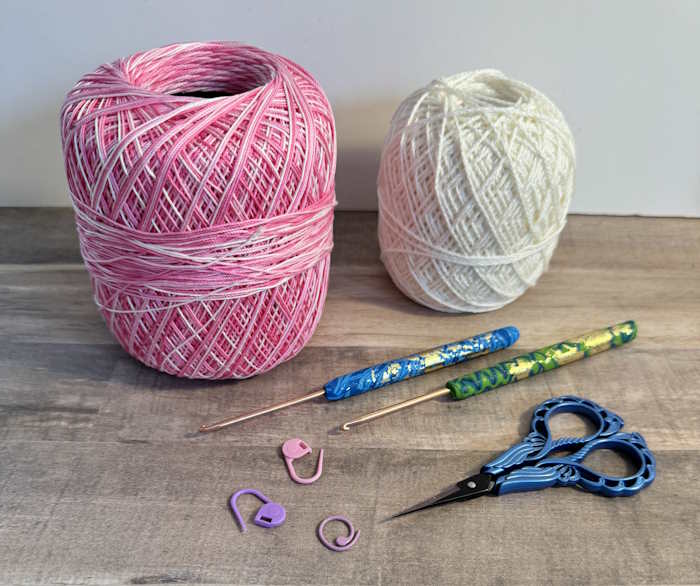 Balls Wrapped Around a Hard Cardboard Core
Balls Wrapped Around a Hard Cardboard CoreDescription: Thin yarn wrapped around a cardboard core is used for fine cotton yarns, metallics, and synthetics. Cotton thread for crocheting is often sold in this manner and is called simply crochet cotton.
Advantages: Tightly wound so it does not take up much space on the shelf
Disadvantages: It may need to be rewound into a ball to make it easier to work.
Fiber Content: Often used with fine cotton, metallics, or other specialty synthetics.
Typical Yarn Weights: They are often fine, fingering or thinner yarns
7. Yarn Barf
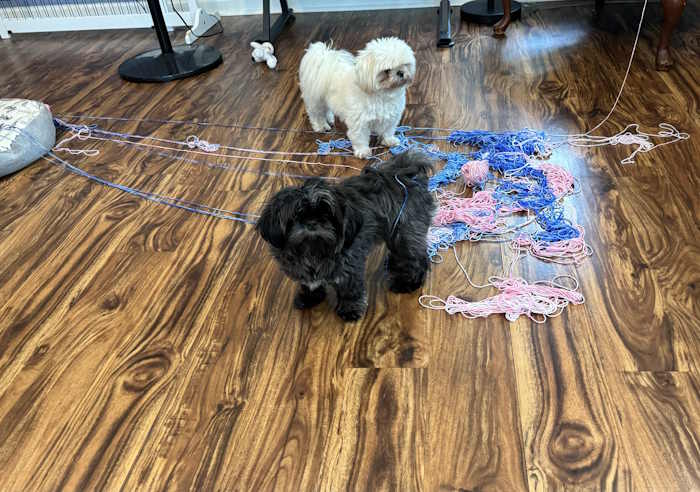 What a Mess!
What a Mess!I couldn’t find another name, but as the name suggests, it is a pile of unraveled yarn that used to be a hank or skein but became unusable and tangled. My dog is famous for creating a mess like this.
Winding the Yarn into a Ball
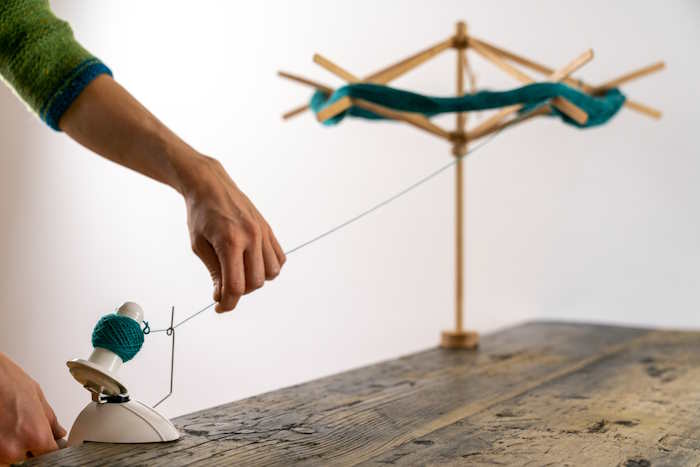 Yarn Swift and Ball Winder
Yarn Swift and Ball WinderBefore you start knitting or crocheting with a ball of yarn, it's usually a good idea to wind the yarn into a ball if it's not already in one.
Here's why:
Prevents Tangles
Winding the yarn helps prevent knots and tangles as you work, ensuring a smooth and enjoyable knitting or crocheting experience.
Fits Into a Yarn Bowl
If you enjoy working with a yarn bowl, the ball will fit nicely inside and be threaded through a slot that allows the yarn to feed easily to your needles or hook.
Even Tension
A well-wound ball allows the yarn to feed evenly, resulting in consistent tension throughout your project.
Convenience
A ball is more accessible to hold and work with than a hank or skein, especially for beginners.
Exception
If your yarn is already in a center-pull ball or cake, you can usually start knitting or crocheting directly.
Here's a Step-by-step Guide on How to Wind Yarn Into a Ball:
What you'll need:
- A yarn swift: (Optional but highly recommended) This tool holds the yarn and allows it to unwind smoothly as you wind, allowing you to wind without the help of others.
- A yarn winder: This handy device makes winding quick and creates a center-pull ball. It can be manual or mechanical.
- Your hands: If you don't have tools, you can wind a ball by hand. Most beginners begin this way and then pick up a swift or yarn winder later.
Method 1: Using a Yarn Swift and Winder:
- Set up: Securely clamp the yarn swift to a table or surface. Place the yarn on the swift, ensuring it unwinds in the correct direction (usually counterclockwise).
- Attach yarn to the winder: Guide the yarn end through the winder's yarn guide and around the notch or key that secures it.
- Start winding: Turn the winder handle clockwise with one hand while using the other to guide the yarn onto the winder gently. Keep the yarn taut but not overly tight.
- Keep winding: Continue winding until all the yarn is on the winder, forming a neat cake.
- Remove the cake: Gently slide the cake off the winder.
Method 2: Winding by Hand: My Method for Countless Years
- Find the end: Locate the end of the yarn on the hank or skein.
- Start winding: Wrap the yarn around your fingers several times to form a small core.
- Shape the ball: Continue wrapping the yarn around the core, changing direction every few wraps to create a balanced, round shape.
- Keep it even: Use your fingers to spread the wraps evenly and prevent the ball from becoming too loose or tight in certain areas.
- Finishing up: Once all the yarn is wound, tuck the end into the ball to secure it.
Tips for that Perfect Ball of Yarn
If winding by hand, ask a friend to hold the yarn to make the process easier, or drape the hank over the back of a chair.
Wipe down your yarn swift or winder periodically with a damp cloth to remove static and prevent the yarn from sticking.
Place the yarn ball label inside the ball, and you will have all the information you need to identify the yarn later.
Be patient and take your time. Winding yarn is a relaxing and meditative activity!
Winding a center-pull ball by hand takes more finesse than regular hand-winding, but it's entirely possible!
Here's how to do it:
1. Step One: Create a Butterfly
Prepare: Find the end of your yarn. Instead of a slip knot, we'll create a "butterfly." Wrap the yarn loosely around your thumb and pinky finger, leaving a loop below.
The Body: Wrap the yarn around your four fingers (excluding the thumb) 10-15 times. Keep it loose.
Wings: Carefully slide the wraps off your hand. Pinch the center of the wrapped yarn, forming "wings."
Wind the Center: Use the loose loop from the beginning to start wrapping around the pinched center of the "butterfly," creating a small core.
2. Step Two: Build the Ball
Switch to Outer Wraps: Once you have a small, stable core, it's time to switch to wrapping around the outer edges of the "butterfly."
Alternate Directions: Like regular hand-winding, alternate wrapping clockwise and counterclockwise every few rounds.
This helps create a balanced ball that won't wobble.
Maintain Even Tension: Keep the yarn tension even throughout. Not too tight, not too loose.
3. Step Three Finishing Touches
Final Wraps: As you near the end of the yarn, begin wrapping back towards the center pull, making smaller and smaller rounds.
Secure the End: Thread the yarn tail through the last loop or tuck it securely under a few wraps.
Beyond the Ball of Yarn Shapes: Where to Buy
Buy Locally
Local Yarn Stores Offer personal service, expertise, and unique yarns. You can feel good about supporting a local business.
Online Retailers
Wide selection, competitive prices, convenience. Here are a few of my favorites:
Craft Stores
If you are lucky enough to be near a local large craft store, they are good for basic yarns and supplies. There is always a sale, so with a little planning you can save some money.
My three go-to stores are Joanns, Hobby Lobby, and Michaels.
Last Words
No matter what your preference or project is, understanding the different forms of yarn packaging can help you make an informed choice and get you stitching with confidence.
